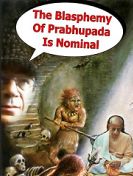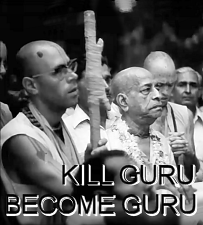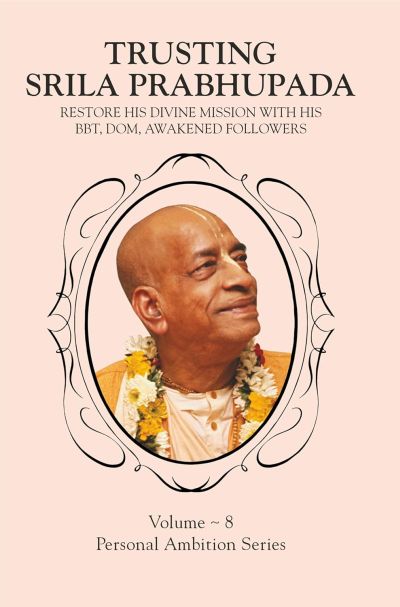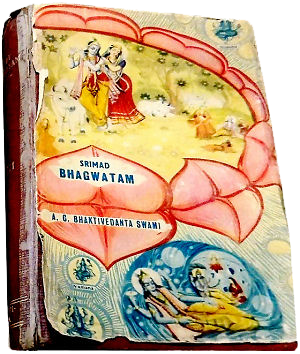httpv://youtu.be/XRCocdRi8vw
Srimati Sita devi (Sri Ramacandra’s consort) avirbhava tithi (appearance day)
Srimati Jahnava devi avirbhava tithi (appearance day)
Sri Madhu Pandita tirobhava tithi (disappearance day)
Srila Prabhupada explains the glories of Srimati Jahnava devi
sri-virabhadra gosani–skandha-mahasakha
tanra upasakha yata, asankhya tara lekha
SYNONYMS
sri-virabhadra gosani—of the name Sri Virabhadra Gosani; skandha—of the trunk; maha-sakha—the biggest branch; tanra—his; upasakha—subbranches; yata—all; asankhya—innumerable; tara—of that; lekha—the description.
TRANSLATION
After Nityananda Prabhu, the greatest branch is Virabhadra Gosani, who also has innumerable branches and subbranches. It is not possible to describe them all.
PURPORT
Srila Bhaktisiddhanta Sarasvati Thakura describes Virabhadra Gosani as the direct son of Srila Nityananda Prabhu and a disciple of Jahnava-devi. His real mother was Vasudha. In the Gaura-ganoddesa-dipika, verse 67, he is mentioned as an incarnation of Ksirodakasayi Visnu. Therefore Virabhadra Gosani is nondifferent from Sri Krsna Caitanya Mahaprabhu.
In a village of the name Jhamatapura, in the district of Hugali, Virabhadra Gosani had a disciple named Yadunathacarya, who had two daughters-a real daughter named Srimati and a foster daughter named Narayani. Both these daughters married, and they are mentioned in Bhakti-ratnakara (Thirteenth Wave). Virabhadra Gosani had three disciples who are celebrated as his sons-Gopijana-vallabha, Ramakrsna and Ramacandra.
The youngest, Ramacandra, belonged to the Sandilya dynasty and had the surname Vatavyala. He established his family at Khadadaha, and its members are known as the gosvamis of Khadadaha. The eldest disciple, Gopijana-vallabha, was a resident of a village known as Lata, near the Manakara railway station in the district of Burdwan.
The second, Ramakrsna, lived near Maladaha, in a village named Gayesapura. Srila Bhaktisiddhanta Sarasvati Thakura notes that since these three disciples belonged to different gotras, or dynasties, and also had different surnames and lived in different places, it is not possible to accept them as real sons of Virabhadra Gosani. Ramacandra had four sons, of whom the eldest was Radhamadhava, whose third son was named Yadavendra.
Yadavendra’s son was Nandakisora, his son was Nidhikrsna, his son was Caitanyacanda, his son was Krsnamohana, his son was Jaganmohana, his son was Vrajanatha, and his son was Syamalala Gosvami. This is the genealogical table given by Bhaktisiddhanta Sarasvati Thakura for the descendants of Virabhadra Gosani.
Sri Caitanya-caritamrta – The Expansions of Lord Nityananda : Adi 11.8
Srila Prabhupada citing Kavi Karnapura’s Gaura-Ganoddesa-Dipika re: the divine position of Jahnava devi
nityanandera gana yata–saba vraja-sakha
srnga-vetra-gopavesa, sire sikhi-pakha
SYNONYMS
nityanandera—of Lord Nityananda Prabhu; gana—followers; yata—all; saba—all; vraja-sakha—residents of Vrndavana; srnga—horn; vetra—cane stick; gopa-vesa—dressed like a cowherd boy; sire—on the head; sikhi-pakha—the plume of a peacock.
TRANSLATION
All the associates of Lord Nityananda were formerly cowherd boys in Vrajabhumi. Their symbolic representations were the horns and sticks they carried, their cowherd dress and the peacock plumes on their heads.
PURPORT
Jahnava-mata is also within the list of Lord Nityananda’s followers. She is described in the Gaura-ganoddesa-dipika, verse 66, as Ananga-manjari of Vrndavana. All the devotees who are followers of Jahnava-mata are counted within the list of Sri Nityananda Prabhu’s devotees.
Sri Caitanya-caritamrta – 1975 Edition The Expansions of Lord Nityananda: Adi 11.21
suryadasa sarakhela, tanra bhai krsnadasa
nityanande drdha visvasa, premera nivasa
SYNONYMS
suryadasa sarakhela—of the name Suryadasa Sarakhela; tanra bhai—his brother; krsnadasa—of the name Krsnadasa; nityanande—unto Lord Nityananda; drdha visvasa—firm faith; premera nivasa—the reservoir of all love of Godhead.
TRANSLATION
Suryadasa Sarakhela and his younger brother Krsnadasa Sarakhela both possessed firm faith in Nityananda Prabhu. They were a reservoir of love of Godhead.
PURPORT
In the Bhakti-ratnakara (Twelfth Wave), it is stated that a few miles from Navadvipa is a place called Saligrama that was the residence of Suryadasa Sarakhela. He was employed as a secretary in the Muslim government of that time, and thus he amassed a good fortune.
Suryadasa had four brothers, all of whom were pure Vaisnavas. Vasudha and Jahnava were two daughters of Suryadasa Sarakhela.
Sri Caitanya-caritamrta The Expansions of Lord Nityananda: Adi 11.25 PURPORT
paramesvara-dasa–nityanandaika-sarana
krsna-bhakti paya, tanre ye kare smarana
SYNONYMS
paramesvara-dasa—of the name Paramesvara dasa; nityananda-eka-sarana—completely surrendered to the lotus feet of Nityananda; krsna-bhakti paya—gets love of Krsna; tanre—him; ye—anyone; kare—does; smarana—remembering.
TRANSLATION
Paramesvara dasa, said to be the fifth gopala of krsna-lila, completely surrendered to the lotus feet of Nityananda. Anyone who remembers his name, Paramesvara dasa, will get love of Krsna very easily.
PURPORT
The Caitanya-bhagavata states that Paramesvara dasa, known sometimes as Paramesvari dasa, was the life and soul of Sri Nityananda Prabhu. The body of Paramesvara dasa was the place of Lord Nityananda’s pastimes. Paramesvara dasa, who lived for some time at Khadadaha village, was always filled with the ecstasy of a cowherd boy.
Formerly he was Arjuna, a friend of Krsna and Balarama. He was the fifth among the twelve gopalas. He accompanied Srimati Jahnava-devi when she performed the festival at Kheturi. It is stated in the Bhakti-ratnakara that by the order of Srimati Jahnava-mata, he installed Radha-Gopinatha in the temple at Atapura in the district of Hugali.
The Atapura station is on the narrow-gauge railway line between Howrah and Amata. Another temple in Atapura, established by the Mitra family, is known as the Radha-Govinda temple. In front of the temple, in a very attractive place among two bakula trees and a kadamba tree, is the tomb of Paramesvari Thakura, and above it is an altar with a tulasi bush. It is said that only one flower a year comes out of the kadamba tree.
It is offered to the Deity. Paramesvari Thakura belonged, it is said, to a vaidya family. A descendant of his brother’s is at present a worshiper in the temple. Some of their family members still reside in the district of Hugali, near the post office of Canditala.
The descendants of Paramesvari Thakura took many disciples from brahmana families, but as these descendants gradually took to the profession of physicians, persons from brahmana families ceased becoming their disciples. The family titles of Paramesvari’s descendants are Adhikari and Gupta. Unfortunately, his family members do not worship the Deity directly; they have engaged paid brahmanas to worship the Deity.
In the temple, Baladeva and Sri Sri Radha-Gopinatha are together on the throne. It is supposed that the Deity of Baladeva was installed later because according to transcendental mellow, Baladeva, Krsna and Radha cannot stay on the same throne. On the full moon day of Vaisakha (April-May), the disappearance festival of Paramesvari Thakura is observed in this temple.
Sri Caitanya-caritamrta Cc. Adi-lila The Expansions of Lord Nityananda Adi 11.29 PURPORT
ajanma nimagna nityanandera carane
nirantara balya-lila kare krsna-sane
SYNONYMS
ajanma—from birth; nimagna—merged; nityanandera—of Lord Nityananda Prabhu; carane—in the lotus feet; nirantara—always; balya-lila—childish play; kare—does; krsna-sane—with Krsna.
TRANSLATION
From birth, Purusottama dasa was merged in the service of the lotus feet of Lord Nityananda Prabhu, and he always engaged in childish play with Lord Krsna.
PURPORT
Sadasiva Kaviraja and Nagara Purusottama, who were father and son, are described in the Caitanya-bhagavata as maha-bhagyavan, greatly fortunate. They belonged to the vaidya caste of physicians. The Gaura-ganoddesa-dipika, verse 156, says that Candravali, a most beloved gopi of Krsna’s, later took birth as Sadasiva Kaviraja.
In verses 194 and 200 it is said that Kamsari Sena, the father of Sadasiva Kaviraja, was formerly the gopi named Ratnavali in Krsna’s pastimes. All the family members of Sadasiva Kaviraja were great devotees of Lord Caitanya Mahaprabhu. Purusottama dasa Thakura sometimes lived at Sukhasagara, near the Cakadaha and Simurali railway stations.
All the Deities installed by Purusottama Thakura were formerly situated in Beledanga-grama, but when the temple was destroyed the Deities were brought to Sukhasagara. When that temple merged into the bed of the Ganges, the Deities were brought with Jahnava-mata’s Deity to Sahebadanga Bedigrama.
Since that place also has been destroyed, all the Deities are now situated in the village named Candude-grama, which is situated one mile up from Palapada, as referred to above.
Sri Caitanya-caritamrta The Expansions of Lord Nityananda Adi 11.39 : PURPORT
tanra putra–mahasaya sri-kanu thakura
yanra dehe rahe krsna-premamrta-pura
SYNONYMS
tanra putra—his son; mahasaya—a respectable gentleman; sri-kanu thakura—of the name Sri Kanu Thakura; yanra—whose; dehe—in the body; rahe—remained; krsna-prema-amrta-pura—the nectar of devotional service to Krsna.
TRANSLATION
Sri Kanu Thakura, a very respectable gentleman, was the son of Purusottama dasa Thakura. He was such a great devotee that Lord Krsna always lived in his body.
PURPORT
To go to the headquarters of Kanu Thakura, one has to proceed by boat from the Jhikaragacha-ghata station to the river known as Kapotaksa. Otherwise, if one goes about two or two and a half miles from the Jhikaragacha-ghata station, he can see Bodhakhana, the headquarters of Kanu Thakura. The son of Sadasiva was Purusottama Thakura, and his son was Kanu Thakura.
The descendants of Kanu Thakura know him as Nagara Purusottama. He was the cowherd boy named Dama during krsna-lila. It is said that just after the birth of Kanu Thakura, his mother, Jahnava, died. When he was about twelve days old, Sri Nityananda Prabhu took him to His home at Khadadaha. It is ascertained that Kanu Thakura was born some time in the Bengali year 942 (A.D. 1535). It is said that he took birth on the Ratha-yatra day.
Because he was a great devotee of Lord Krsna from the very beginning of his life, Sri Nityananda Prabhu gave him the name Sisu Krsnadasa. When he was five years old he went to Vrndavana with Jahnava-mata, and upon seeing the ecstatic symptoms of Kanu Thakura, the Gosvamis gave him the name Kanai Thakura.
In the family of Kanu Thakura there is a Radha-Krsna Deity known as Pranavallabha. It is said that his family worshiped this Deity long before the appearance of Lord Caitanya Mahaprabhu. When there was a Maharashtrian invasion of Bengal, the family of Kanu Thakura was scattered, and after the invasion one Harikrsna Gosvami of that family came back to their original home, Bodhakhana, and re-established the Pranavallabha Deity.
The descendants of the family still engage in the service of Pranavallabha. Kanu Thakura was present during the Khetari utsava, when Jahnava-devi and Virabhadra Gosvami were also present. One of Kanu Thakura’s family members, Madhavacarya, married the daughter of Sri Nityananda Prabhu, who was named Gangadevi.
Both Purusottama Thakura and Kanu Thakura had many disciples from brahmana families. Most of the disciplic descendants of Kanu Thakura now reside in the village named Gadabeta, by the river Silavati, in the Midnapore district.
Books : Sri Caitanya-caritamrta – 1975 Edition : Cc. Adi-lila : Adi 11: The Expansions of Lord Nityananda : Adi 11.40
Srila Prabhupada re Sita-Tattva
asmat-prasada-sumukhah kalaya kalesa
iksvaku-vamsa avatirya guror nidese
tisthan vanam sa-dayitanuja avivesa
yasmin virudhya dasa-kandhara artim arcchat
SYNONYMS
asmat—unto us, beginning from Brahma down to the insignificant ant; prasada—causeless mercy; sumukhah—so inclined; kalaya—with His plenary extensions; kalesah—the Lord of all potencies; iksvaku—Maharaja Iksvaku, in the dynasty of the sun; vamse—family; avatirya—by descending in; guroh—of the father or spiritual master; nidese—under the order of; tisthan—being situated in; vanam—in the forest; sa-dayita-anujah—along with His wife and younger brother; avivesa—entered; yasmin—unto whom; virudhya—being rebellious; dasa-kandharah—Ravana, who had ten heads; artim—great distress; arcchat—achieved.
Due to His causeless mercy upon all living entities within the universe, the Supreme Personality of Godhead, along with His plenary extensions, appeared in the family of Maharaja Iksvaku as the Lord of His internal potency, Sita. Under the order of His father, Maharaja Dasaratha, He entered the forest and lived there for considerable years with His wife and younger brother. Ravana, who was very materially powerful, with ten heads on his shoulders, committed a great offense against Him and was thus ultimately vanquished.
Lord Rama is the Supreme Personality of Godhead, and His brothers, namely Bharata, Laksmana and Satrughna, are His plenary expansions. All four brothers are visnu-tattva and were never ordinary human beings. There are many unscrupulous and ignorant commentators on Ramayana who present the younger brothers of Lord Ramacandra as ordinary living entities.
But here in the Srimad-Bhagavatam, the most authentic scripture on the science of Godhead, it is clearly stated that His brothers were His plenary expansions. Originally Lord Ramacandra is the incarnation of Vasudeva, Laksmana is the incarnation of Sankarsana, Bharata is the incarnation of Pradyumna, and Satrughna is the incarnation of Aniruddha, expansions of the Personality of Godhead.
Laksmiji Sita is the internal potency of the Lord and is neither an ordinary woman nor the external potency incarnation of Durga. Durga is the external potency of the Lord, and she is associated with Lord Siva.
As stated in the Bhagavad-gita (4.7), the Lord appears when there are discrepancies in the discharge of factual religion. Lord Ramacandra also appeared under the same circumstances, accompanied by His brothers, who are expansions of the Lord’s internal potency, and by Laksmiji Sitadevi.
Lord Ramacandra was ordered by His father, Maharaja Dasaratha, to leave home for the forest under awkward circumstances, and the Lord, as the ideal son of His father, carried out the order, even on the occasion of His being declared the King of Ayodhya. One of His younger brothers, Laksmanaji, desired to go with Him, and so also His eternal wife, Sitaji, desired to go with Him.
The Lord agreed to both of them, and all together they entered the Dandakaranya Forest, to live there for fourteen years. During their stay in the forest, there was some quarrel between Ramacandra and Ravana, and the latter kidnapped the Lord’s wife, Sita. The quarrel ended in the vanquishing of the greatly powerful Ravana, along with all his kingdom and family.
Sita is Laksmiji, or the goddess of fortune, but she is never to be enjoyed by any living being. She is meant for being worshiped by the living being along with her husband, Sri Ramacandra. A materialistic man like Ravana does not understand this great truth, but on the contrary he wants to snatch Sitadevi from the custody of Rama and thus incurs great miseries.
The materialists, who are after opulence and material prosperity, may take lessons from the Ramayana that the policy of exploiting the nature of the Lord without acknowledging the supremacy of the Supreme Lord is the policy of Ravana.
Ravana was very advanced materially, so much so that he turned his kingdom, Lanka, into pure gold, or full material wealth. But because he did not recognize the supremacy of Lord Ramacandra and defied Him by stealing His wife, Sita, Ravana was killed, and all his opulence and power were destroyed.
Lord Ramacandra is a full incarnation with six opulences in full, and He is therefore mentioned in this verse as kalesah, or master of all opulence.
Srimad-Bhagavatam Scheduled Incarnations with Specific Functions 2.7.23
There are innumerable universes, and somewhere or other the boar form is now existing. All the forms of the Lord are eternal. It is the devotee’s inclination to worship a particular form, and he engages in devotional service to that form.
In a verse in the Ramayana, Hanuman, the great devotee of Rama, said, “I know that there is no difference between the Sita-Rama and Laksmi-Narayana forms of the Supreme Personality of Godhead, but nevertheless, the form of Rama and Sita has absorbed my affection and love. Therefore I want to see the Lord in the forms of Rama and Sita.
Srimad-Bhagavatam Conversation Between Maitreya and Vidura : SB 3.20.25
In the Brahma-samhita it is stated that the Lord is one Absolute, but He has ananta, or innumerable, forms. Advaitam acyutam anadim ananta-rupam [Bs 5.33]. The Lord is the original form, but still He has multiforms.
Those multiforms are manifested by Him transcendentally, according to the tastes of His multidevotees. It is understood that once Hanuman, the great devotee of Lord Ramacandra, said that he knew that Narayana, the husband of Laksmi, and Rama, the husband of Sita, are one and the same, and that there is no difference between Laksmi and Sita, but as for himself, he liked the form of Lord Rama.
In a similar way, some devotees worship the original form of Krsna. When we say “Krsna” we refer to all forms of the Lord—not only Krsna, but Rama, Nrsimha, Varaha, Narayana, etc. The varieties of transcendental forms exist simultaneously. That is also stated in the Brahma-samhita: ramadi-murtisu. .. nanavataram.
He already exists in multiforms, but none of the forms are material. Sridhara Svami has commented that arupinah, “without form,” means without material form. The Lord has form, otherwise how can it be stated here, tany eva te ’bhirupani rupani bhagavams tava: “You have Your forms, but they are not material.
Materially You have no form, but spiritually, transcendentally, You have multiforms”? Mayavadi philosophers cannot understand these transcendental forms of the Lord, and being disappointed, they say that the Supreme Lord is impersonal. But that is not a fact; whenever there is form there is a person. Many times in many Vedic literatures the Lord is described as purusa, which means “the original form, the original enjoyer.”
The conclusion is that the Lord has no material form, and yet, according to the liking of different grades of devotees, He simultaneously exists in multiforms, such as Rama, Nrsimha, Varaha, Narayana and Mukunda. There are many thousands and thousands of forms, but they are all visnu-tattva, Krsna.
Srimad Bhagavatam The Renunciation of Kardama Muni : SB 3.24.31
cakravarti sivananda sada vrajavasi
mahasakha-madhye tenho sudrdha visvasi
SYNONYMS
cakravarti sivananda—of the name Sivananda Cakravarti; sada—always; vraja-vasi—resident of Vrndavana; maha-sakha-madhye—amongst the great branches; tenho—he is; sudrdha visvasi—possessing firm faith.
TRANSLATION
Sivananda Cakravarti, the thirty-third branch, who always lived in Vrndavana with firm conviction, is considered an important branch of Gadadhara Pandita.
PURPORT
The Gaura-ganoddesa-dipika, verse 183, mentions that Sivananda Cakravarti was formerly Lavanga-manjari. The Sakha-nirnaya, written by Yadunandana dasa, also names other branches of Gadadhara Pandita, as follows: (1) Madhava Acarya, (2) Gopala dasa, (3) Hrdayananda, (4) Vallabha Bhatta (the Vallabha-sampradaya, or Pustimarga-sampradaya, is very famous), (5) Madhu Pandita (this famous devotee lived near Khadadaha in the village known as Sanibona-grama, about two miles east of the Khadadaha station, and constructed the temple of Gopinathaji in Vrndavana), (6) Acyutananda, (7) Candrasekhara, (8) Vakresvara Pandita, (9) Damodara, (10) Bhagavan Acarya, (11) Ananta Acaryavarya, (12) Krsnadasa, (13) Paramananda Bhattacarya, (14) Bhavananda Gosvami, (15) Caitanya dasa, (16) Lokanatha Bhatta (this devotee, who lived in the village of Talakhadi in the district of Yasohara and constructed the temple of Radhavinoda, was the spiritual master of Narottama dasa Thakura and a great friend of Bhugarbha Gosvami), (17) Govinda Acarya, (18) Akrura Thakura, (19) Sanketa Acarya, (20) Pratapaditya, (21) Kamalakanta Acarya, (22) Yadava Acarya and (23) Narayana Padihari (a resident of Jagannatha Puri).
Sri Caitanya-caritamrta. CCAdi-lila : Adi 12: The Expansions of Advaita Acarya and Gadadhara Pandita.
‘govinda’ bhakta, ara vani-krsnadasa
pundarikaksa, isana, ara laghu-haridasa
SYNONYMS
govinda—Govinda; bhakta—a great devotee; ara—and; vani-krsnadasa—Vani Krsnadasa; pundarikaksa—Pundarikaksa; isana—Isana; ara—and; laghu-haridasa—Laghu Haridasa.
TRANSLATION
The great devotee Govinda, Vani Krsnadasa, Pundarikaksa, Isana and Laghu Haridasa also accompanied him.
PURPORT
Laghu Haridasa should not be confused with Junior Haridasa, who committed suicide at Prayaga. Generally a devotee is called Haridasa, and consequently there are many Haridasas. The chief was Thakura Haridasa. There was also a Madhyama Haridasa.
In Bhakti-ratnakara (Sixth Wave), there is a list of many of the chief devotees who accompanied Srila Rupa Gosvami.
gosvami gopala-bhatta ati dayamaya
bhugarbha, sri-lokanatha–gunera alaya
sri-madhava, sri-paramananda-bhattacarya
sri-madhu-pandita–yanra caritra ascarya
premi krsnadasa krsnadasa brahmacari
yadava acarya, narayana krpavan
sri-pundarikaksa-gosani, govinda, isana
sri-govinda vani-krsnadasa aty-udara
sri-uddhava–madhye-madhye gaude gati yanra
dvija-haridasa krsnadasa kaviraja
sri-gopala-dasa yanra alaukika kaya
sri-gopala, madhavadi yateka vaisnava
“The following Vaisnavas were present with Srila Rupa Gosvami: the merciful Gopala Bhatta Gosvami; Bhugarbha Gosvami; Sri Lokanatha dasa Gosvami, a reservoir of good qualities; Sri Madhava; Sri Paramananda Bhattacarya; Sri Madhu Pandita, whose characteristics are all wonderful; Premi Krsnadasa; Krsnadasa Brahmacari; Yadava Acarya; the merciful Narayana; Sri Pundarikaksa Gosvami; Govinda; Isana; Sri Govinda; the magnanimous Vani Krsnadasa; Sri Uddhava, who occasionally visited Bengal; Dvija Haridasa; Krsnadasa Kaviraja; Sri Gopala dasa, whose body is completely spiritual; Sri Gopala; Madhava; and many others.”
Sri Caitanya-caritamrta – Madhya-lila Lord Sri Caitanya Mahaprabhu’s Visit to Sri Vrndavana Madhya 18.52:







Speak Your Mind